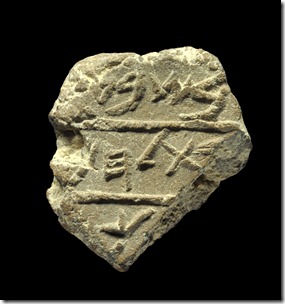The Israel Antiquities Authority announced today the discovery of a seal impression with the name of Bethlehem.
The first ancient artifact constituting tangible evidence of the existence of the city of Bethlehem, which is mentioned in the Bible, was recently discovered in Jerusalem.
A bulla measuring c. 1.5 cm was found during the sifting of soil removed from archaeological excavations the Israel Antiquities Authority is carrying out in the City of David. The sifting is underwritten by the ‘Ir David Foundation’ in a project being conducted in the Emek Tzurim National Park.
A bulla is a piece of clay that was used for sealing a document or object. The bulla was impressed with the seal of the person who sent the document or object, and its integrity was evidence the document or object was not opened by anyone unauthorized to do so.
Three lines of ancient Hebrew script appear on the bulla:
בשבעת Bishv’at [in the seventh]
בת לחם Bat Lechem [Bethlehem]
[למל]ך [Lemel]ekh [for the king]
According to Eli Shukron, director of the excavation on behalf of the Israel Antiquities Authority, “it seems that in the seventh year of the reign of a king (it is unclear if the king referred to here is Hezekiah, Manasseh or Josiah), a shipment was dispatched from Bethlehem to the king in Jerusalem. The bulla we found belongs to the group of “fiscal” bullae – administrative bullae used to seal tax shipments remitted to the taxation system of the Kingdom of Judah in the late eighth and seventh centuries BCE. The tax could have been paid in the form of silver or agricultural produce such as wine or wheat”.
Shukron emphasizes, “this is the first time the name Bethlehem appears outside the Bible, in an inscription from the First Temple period, which proves that Bethlehem was indeed a city in the Kingdom of Judah, and possibly also in earlier periods”.
Too much can be made from this discovery, especially with the emphasis of the last sentence above.
The existence of Bethlehem in the period of the Old Testament is not disputed, and an inscription this late is not as helpful as one would be from the time of Ruth or David. Nonetheless, it is a nice discovery which adds another piece of data to our understanding of the Judean kingdom.
The closest biblical connection that one can make to this time period (late 8th or 7th century) is the prophet Micah, who derided the failed leadership of his day (chapter 3), predicted a restored Davidic kingdom (chapter 4), and expected that Bethlehem would produce the awaited king, one whose origins are from ancient times and who would “be their peace” (chapter 5).
The full press release is here and a high-resolution photo is here (also below). The story is reported by the Jerusalem Post, Reuters, the Associated Press, and many others.
Photograph by Clara Amit, courtesy of the Israel Antiquities Authority.
